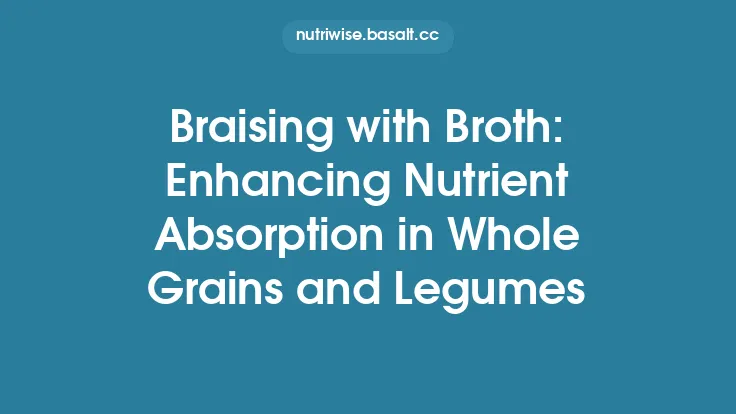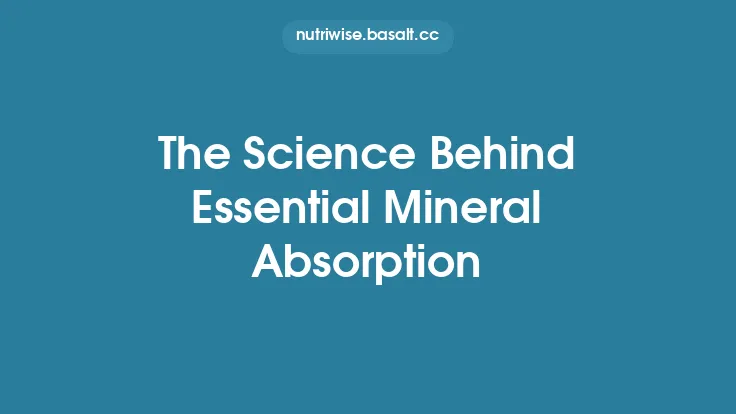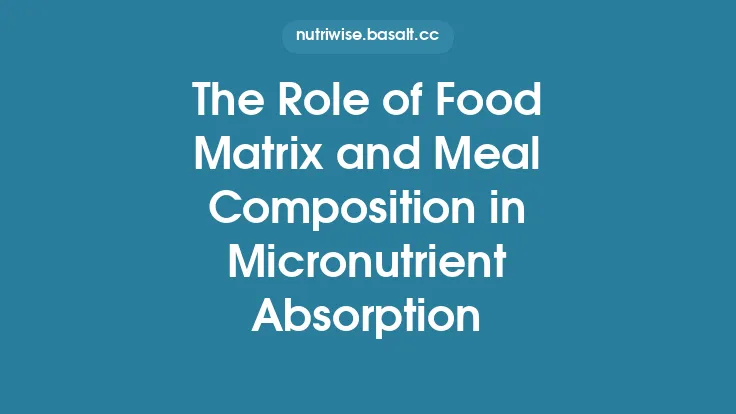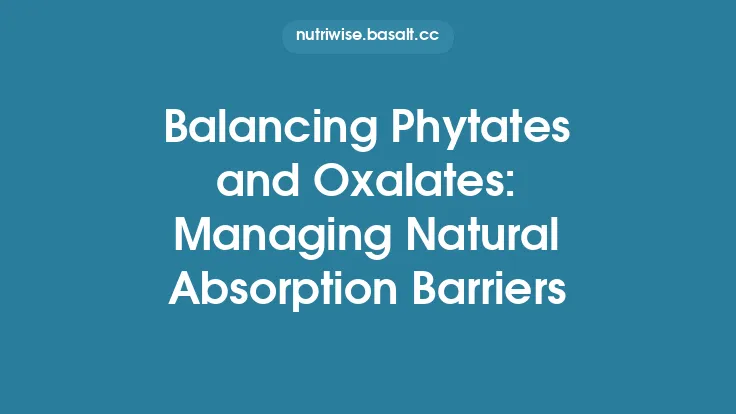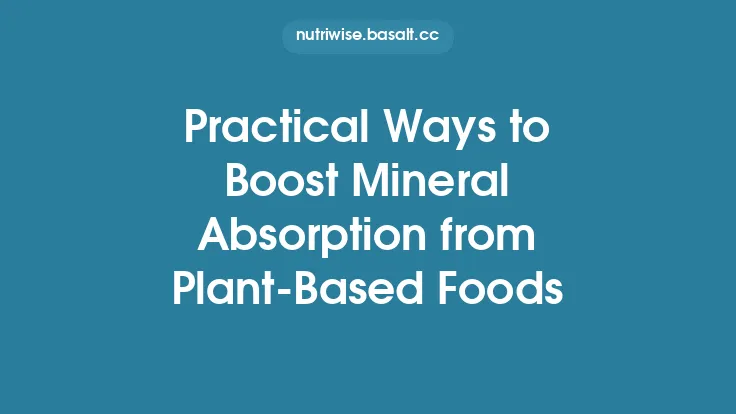Mineral nutrition is a cornerstone of human health, yet the proportion of ingested minerals that actually reach systemic circulation can vary dramatically. While the body possesses sophisticated transport systems, the chemical environment surrounding a mineral ion at the moment of ingestion exerts a decisive influence on whether that ion will be absorbed or remain bound in the intestinal lumen. Natural compounds—both those that facilitate transport and those that impede it—are ubiquitous in plant and animal foods. Understanding how these enhancers and inhibitors operate at a molecular level equips nutrition scientists, product developers, and health‑conscious consumers with the tools to design foods and supplements that maximize mineral bioavailability without resorting to synthetic additives.
Mechanistic Basis of Mineral Absorption
Mineral ions cross the intestinal epithelium via two principal pathways:
- Carrier‑mediated transport – Specific transporters (e.g., DMT1 for Fe²⁺, ZIP4 for Zn²⁺, TRPV6 for Ca²⁺) recognize the ionic form and facilitate its entry into enterocytes. The affinity of these carriers is highly sensitive to the mineral’s oxidation state and its coordination environment.
- Paracellular diffusion – Tight‑junction permeability allows small, uncharged complexes to slip between cells. This route is especially relevant for calcium and magnesium when they are present as neutral complexes (e.g., calcium citrate).
Both pathways are modulated by the presence of ligands that can either chelate the mineral, preserving it in a soluble, transport‑ready form, or precipitate it, rendering it insoluble and unavailable. The balance between these opposing actions is dictated by the thermodynamic stability constants (K_f) of the mineral‑ligand complexes, the pH of the intestinal lumen, and the concentration of competing ions.
Key Natural Enhancers of Mineral Uptake
| Enhancer | Primary Minerals Affected | Mode of Action | Representative Food Sources |
|---|---|---|---|
| Citric Acid | Fe²⁺, Ca²⁺, Mg²⁺, Zn²⁺ | Forms soluble citrate complexes (K_f ≈ 10⁴–10⁶) that resist precipitation at intestinal pH (≈6–7). | Citrus fruits, berries, tomatoes |
| Malic Acid | Fe²⁺, Ca²⁺ | Similar to citrate but with a slightly lower stability constant, still effective at maintaining solubility. | Apples, cherries, grapes |
| Lactate (Lactic Acid) | Ca²⁺, Mg²⁺ | Generates calcium lactate, a highly soluble salt; also lowers luminal pH modestly, enhancing dissolution of mineral salts. | Fermented dairy, sourdough |
| Amino Acids (Cysteine, Histidine, Glycine) | Fe²⁺, Zn²⁺, Cu²⁺ | Form neutral metal‑amino acid complexes that can be transported via peptide transporters (PEPT1) or remain soluble for carrier uptake. | Protein‑rich foods, especially animal sources |
| Vitamin D Metabolites (1,25‑(OH)₂D₃) | Ca²⁺, PO₄³⁻ | Up‑regulates expression of TRPV6 and calbindin, increasing transcellular calcium transport. Though a vitamin, its active metabolite functions as a physiological enhancer. | Sun‑derived synthesis; fortified foods |
| Short‑Chain Fatty Acids (SCFAs) – Propionate, Butyrate | Ca²⁺, Mg²⁺ | SCFAs lower colonic pH, improving solubility of divalent cations; also stimulate expression of calcium‑binding proteins. | Fermented fibers, resistant starch fermentation |
| Phytochemicals (Quercetin, Kaempferol) – at low concentrations | Fe²⁺ | Act as mild chelators that keep iron in a soluble, reduced state without forming insoluble precipitates. | Onions, kale, apples (in modest amounts) |
Key Takeaway: The most potent natural enhancers are organic acids that generate highly soluble mineral complexes and amino acids that create neutral, transport‑friendly chelates. Their effectiveness is amplified when present in concentrations that exceed the mineral’s binding capacity, thereby saturating potential inhibitory sites.
Prominent Natural Inhibitors and Their Modes of Action
| Inhibitor | Minerals Most Affected | Mechanistic Detail | Typical Food Occurrence |
|---|---|---|---|
| Polyphenols (Tannins, Catechins) | Fe²⁺, Zn²⁺, Cu²⁺ | Form high‑affinity, often insoluble complexes (K_f > 10⁸) that precipitate at intestinal pH, reducing free ion concentration. | Tea, coffee, red wine, legumes |
| Phytic Acid (Inositol Hexakisphosphate) | Fe²⁺, Zn²⁺, Ca²⁺, Mg²⁺ | Strong chelator (K_f ≈ 10⁵–10⁶) that creates insoluble phytate‑mineral salts, especially under neutral to alkaline conditions. | Whole grains, seeds, nuts |
| Oxalic Acid | Ca²⁺, Fe²⁺ | Forms calcium oxalate crystals (K_sp ≈ 2 × 10⁻⁹) that are poorly soluble and pass unabsorbed. | Spinach, rhubarb, beet greens |
| Excess Dietary Calcium | Non‑heme iron | Competes for DMT1 transport and can precipitate iron as calcium‑iron complexes, especially when calcium intake exceeds 500 mg per meal. | Dairy‑rich meals |
| High Sodium Load | Calcium | Sodium can increase urinary calcium excretion, indirectly lowering net calcium retention. | Processed foods, salted snacks |
| Sulphur‑Containing Compounds (e.g., glucosinolates) | Iodine, Selenium | Interfere with thyroid hormone synthesis, indirectly affecting iodine utilization. | Cruciferous vegetables |
Note: While many of these inhibitors are discussed in other guides (e.g., phytates and oxalates), the focus here is on their *mechanistic* impact on mineral complexation rather than strategies for balancing them.
Strategic Use of Enhancers to Counteract Inhibitors
- Stoichiometric Over‑Saturation
By supplying an excess of a high‑affinity enhancer (e.g., citrate), the free mineral ion can be driven into a soluble complex that outcompetes inhibitor binding. For instance, a molar ratio of citrate : Fe²⁺ ≥ 2:1 can shift equilibrium away from tannin‑iron complexes.
- pH Modulation
Organic acids lower the luminal pH, which reduces the deprotonation of polyphenolic hydroxyl groups, thereby weakening their chelation capacity. A modest pH drop from 6.8 to 5.5 can increase iron solubility by up to 30 % in the presence of tea polyphenols.
- Sequential Release Formulations
Encapsulating an inhibitor‑rich ingredient in a delayed‑release matrix while co‑encapsulating an enhancer in an immediate‑release coating ensures that the enhancer is available to bind the mineral before the inhibitor can act. This approach is common in fortified beverages where calcium carbonate is paired with citric acid in separate micro‑capsules.
- Ligand Exchange Catalysis
Certain amino acids (e.g., histidine) can act as *trans‑chelators*, displacing a mineral from an inhibitory complex and forming a new, transport‑ready complex. In vitro studies show that histidine can recover up to 70 % of iron bound to phytate under simulated intestinal conditions.
- Co‑administration of Reducing Agents
For iron, maintaining the ferrous (Fe²⁺) state is crucial. Ascorbic acid not only chelates iron but also reduces ferric (Fe³⁺) to ferrous, thereby enhancing DMT1 affinity. Even low concentrations (10–20 mg) can have a measurable effect when paired with iron‑rich foods.
Considerations for Supplement Formulations
- Complex Stability vs. Release Kinetics
A supplement that pre‑forms a mineral‑citrate complex must balance stability (to survive gastric acidity) with the ability to dissociate at the duodenal pH where absorption occurs. Enteric coating can protect the complex until it reaches the optimal pH window.
- Synergistic Enhancer Blends
Combining citrate with amino acids (e.g., glycine) can create mixed‑ligand complexes that exhibit higher solubility than either ligand alone. Such synergism has been demonstrated for zinc, where zinc‑citrate‑glycinate shows a 1.5‑fold increase in Caco‑2 cell uptake compared with zinc citrate.
- Avoiding Antagonistic Interactions
High calcium levels can inhibit iron absorption; therefore, iron supplements should be formulated without calcium salts or with calcium‑binding enhancers (e.g., citrate) that keep calcium in a non‑interfering form.
- Dose‑Dependent Effects of Polyphenols
While polyphenols can inhibit mineral uptake at high concentrations, low‑dose inclusion (≤ 30 mg catechin per serving) may provide antioxidant benefits without appreciable mineral interference. Formulators must therefore define a “threshold” concentration for each polyphenol.
Research Frontiers and Emerging Natural Modulators
- Peptidic Chelators from Fermented Foods
Recent proteomic analyses have identified short peptides (2–5 amino acids) in kefir and tempeh that bind iron with moderate affinity (K_f ≈ 10³). These peptides appear to be transported via PEPT1, offering a dual pathway for iron delivery.
- Plant‑Derived Siderophores
Certain legumes produce siderophore‑like molecules (e.g., nicotianamine) that chelate iron and zinc. Early in‑vitro work suggests that these compounds can bypass traditional inhibitors and enhance transcellular transport.
- Bioengineered Organic Acids
Metabolic engineering of yeast strains to overproduce malic and citric acids is being explored for use in fortified beverages, providing a natural, high‑concentration source of enhancers without synthetic additives.
- Nanostructured Mineral‑Ligand Complexes
Nano‑emulsions of calcium‑citrate have shown increased intestinal permeability in animal models, likely due to enhanced mucosal contact surface area. Translational research is ongoing to assess safety and efficacy in humans.
Integrating Natural Enhancers into Food Systems
When designing a mineral‑enriched product, the following workflow can help align scientific insight with practical development:
- Identify the Target Mineral and Its Primary Inhibitors
Conduct a compositional audit of the base matrix to pinpoint likely inhibitory compounds (e.g., high tannin content in a cocoa‑based drink).
- Select Complementary Enhancers Based on Thermodynamic Compatibility
Choose enhancers whose stability constants exceed those of the inhibitors for the same mineral. For iron in a cocoa matrix, citric acid (K_f ≈ 10⁵) outcompetes tannin‑iron complexes (K_f ≈ 10⁸) only when present in sufficient molar excess.
- Model pH and Ionic Strength Effects
Use speciation software (e.g., Visual MINTEQ) to simulate the intestinal environment and predict the proportion of mineral existing as free ion versus bound complex.
- Prototype with Controlled Release Technologies
Apply micro‑encapsulation or layered coating to separate enhancers from inhibitors temporally, ensuring that the enhancer is bioavailable at the point of absorption.
- Validate with In‑Vitro Absorption Assays
Employ Caco‑2 or intestinal organoid models to quantify uptake improvements relative to a control formulation.
- Iterate Based on Sensory and Stability Data
Verify that the addition of enhancers does not compromise taste, texture, or shelf‑life, adjusting concentrations or employing flavor‑masking strategies as needed.
By leveraging the intrinsic chemistry of natural enhancers—organic acids, amino acids, and specific phytochemicals—while accounting for the potent chelating capacity of naturally occurring inhibitors, it is possible to construct food and supplement products that deliver minerals with markedly improved bioavailability. This approach respects the body’s physiological pathways, avoids reliance on synthetic additives, and aligns with consumer demand for clean‑label nutrition solutions.
